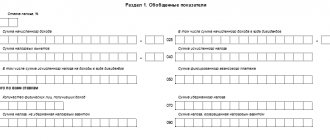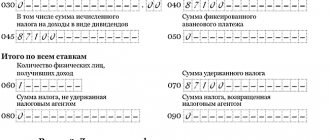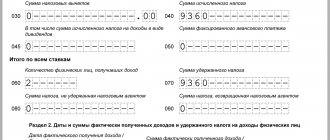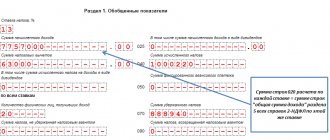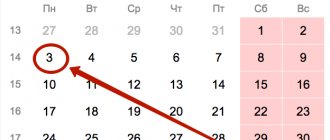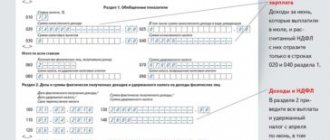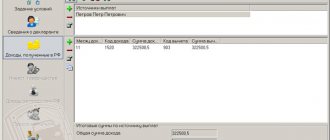Dates of receipt of income and withholding of personal income tax
Unlike salary, the day of actual receipt of income for which is considered the last day of the month, the day of receipt of income for vacation pay (including compensation for unused vacation upon dismissal) and sick leave is considered the date on which they were transferred to the employee’s bank account, or paid in cash (clause 1, clause 1, article 223 of the Tax Code of the Russian Federation).
The employer must pay vacation pay to the employee 3 working days before the vacation. As for sick leave benefits, the employer accrues them on the basis of sick leave within a 10-day period, paying them on the next “payday” day.
“Vacation pay” and “sick leave” personal income tax, as well as tax on other income, must be withheld on the day of their payment, and transferred to the budget no later than the last date of the month of payment to the employee, taking into account the transfer to the next working day if it coincides with weekends and holidays (p 6 Article 226 of the Tax Code of the Russian Federation). Let us remind you that for tax withheld from salary and compensation for vacation, the transfer deadline is the next day after payment of income.
These features of reflecting dates, common for sick leave and vacation pay, must be taken into account when filling out section 2 of the 6-NDFL calculation.
Sick leave during vacation with transfer of rest days
The employee was on vacation from June 18 to July 15.
On June 14, he was paid vacation pay in the amount of 22,209.32 rubles. (Personal income tax - 2,887 rubles). From July 5 to July 11, the employee was ill. In July, he brought sick leave for these dates. The accountant reversed vacation pay of RUB 5,552.33. (personal income tax - 722 rubles) and accrued sick leave benefits of 4,550.28 rubles. (Personal income tax - 592 rubles). The employee decided to postpone the vacation days to another time, and for the overpaid vacation pay he wrote an application to offset these amounts against the allowance and subsequent payments. As a result, on July 25 (the date the “advance” was issued in the organization), the employee was not entitled to any payments, and on August 10 he received his salary for July, reduced by the amount owed. The payment amount was 28,997.95 rubles. (Personal income tax amounted to 3,900 rubles, since withholding does not affect the base). In fact, the benefit was not paid, since it was completely “covered” by the reversed vacation pay. How to correctly reflect these payments in the calculation of 6-NDFL? If temporary disability occurs during annual paid leave, it must be extended or postponed to another period determined by the employer taking into account the wishes of the employee (Article 124 of the Labor Code of the Russian Federation). Since in the situation under consideration the vacation is not extended, but transferred, part of the vacation pay accrued for the days of vacation on which the employee was incapacitated is over-accrued (paid). But since the date of receipt of income in the form of average earnings saved during vacation is the date of actual payment (transfer) of money (subclause 1, paragraph 1, article 223 of the Tax Code of the Russian Federation), personal income tax was withheld immediately from the entire amount of vacation pay even when actual payment in June. Consequently, after recalculation, part of the vacation pay for unused vacation days becomes excessively withheld.
According to paragraph 3 of Article 226 of the Tax Code of the Russian Federation, an organization must determine the tax base for personal income tax in relation to a given employee on an accrual basis from the beginning of the year, that is, taking into account the reversed amount of vacation pay and the amount of excess personal income tax withheld. Thus, the withholding of personal income tax on subsequent payments of income to this employee should be made taking into account the excessively withheld tax on vacation pay. In a normal situation, such an offset would be made when the benefit is paid. However, in our case, the amount of the benefit was less than the “extra” vacation pay, so there was no actual payment.
According to the rules of paragraph 2 of paragraph 1 of Article 210 of the Tax Code of the Russian Federation, deductions that are made from the taxpayer’s income by his order do not reduce the tax base for personal income tax. This means that, although the organization credited the benefit against previously paid vacation pay, operations for its accrual and for calculating personal income tax on the amount of the benefit must still be reflected in both tax accounting registers and reporting. Moreover, all amounts are reflected without deductions. Moreover, by virtue of paragraph 1 of Article 210 and subparagraph 1 of paragraph 1 of Article 223 of the Tax Code of the Russian Federation, such a credited amount is considered to be actually received by the employee, because he ordered it, asking to be credited against previously paid vacation pay (he ordered the amount of the benefit to be credited to the employer’s account).
In a similar way, the salary adjustment will be reflected in the amount of overpaid vacation pay, which exceeds the amount of the benefit. That is, the salary amount will need to be reflected without taking into account withholding, and only the amount of withheld tax will be adjusted, which is reflected on line 140 of section 2 of the 6-NDFL calculation. In the reporting, this operation will be shown when the salary for July is paid on August 10.
As for the amount of vacation pay paid in June, which is indicated in the calculation of 6-NDFL for the half-year, it will have to be adjusted by submitting the corresponding updated calculation.
Submit 6‑NDFL online for free
Please note: the amount of personal income tax withheld when paying vacation pay, indicated in the calculation of 6-personal income tax (line 140 of section 2 and line 070 of section 1), is not subject to adjustment. Only the amount of accrued income (lines 130 and 020) and the tax calculated on it (line 040) is adjusted.
Example 1
Let's see how Section 2 of the 6-NDFL calculation will be completed for each payment.
For vacation pay (updated calculation for half a year):
- Line 100 “Date of actual receipt of income” - 06/14/2016;
- Line 110 “Date of tax withholding” - 06/14/2016;
- Line 120 “Tax payment deadline” - 06/30/2016;
- Line 130 “Amount of income actually received” - 16,656.99 (22,209.32 rubles - 5,552.33 rubles);
- Line 140 “Amount of tax withheld” - 2,887.
For sick leave benefits (calculation for nine months):
- Line 100 “Date of actual receipt of income” - 07/25/2016;
- Line 110 “Date of tax withholding” - 07/25/2016;
- Line 120 “Tax payment deadline” - 08/01/2016;
- Line 130 “Amount of income actually received” - 4,550.28;
- Line 140 “Amount of tax withheld” - 0 (592 rubles - 722 rubles).
For wages for July (calculation for nine months):
- Line 100 “Date of actual receipt of income” - 07/31/2016;
- Line 110 “Date of tax withholding” - 08/10/2016;
- Line 120 “Tax payment deadline” - 08/11/2016;
- Line 130 “Amount of income actually received” - 30,000;
- Line 140 “Amount of tax withheld” - 3,770 (3,900 rubles - (722 rubles - 592 rubles)).
Features of reflecting vacation pay in 6-NDFL
When filling out Section 1 of form 6-NDFL, the amounts of vacation pay are shown together with other income of individuals. But in Section 2, vacation pay should be reflected separately from income that has other deadlines for paying personal income tax to the budget. In addition, vacation pay paid on different dates is reflected separately from each other.
For example, in April 2021, the organization paid employees:
- On the 5th, the salary for March is 100,000 rubles, including personal income tax of 13,000 rubles,
- vacation pay for two employees: April 12 - 10,000 rubles. (personal income tax 1300 rubles), April 26 – 8000 rubles. (personal income tax 1040 rub.).
Here is how these amounts will be distributed in 6-personal income tax for the six months:
6-NDFL with an example of sick leave and vacation
Reflection of vacation pay in 6-NDFL: example
To visualize how to reflect vacation pay in the 6-NDFL form, we will give an example.
Marmelad LLC has 3 employees; for the second quarter they were paid the following amounts:
- Salary for April 120,000 rubles – May 04
- Salary for May – 110,000 rubles – June 05
- Vacation pay for an employee - 10,000 rubles - May 15
- Salary for June – 120,000 rubles – July 4
The tax must be transferred on the day the salary is issued. Tax on paid vacation pay was paid to the budget on May 31. Due to the fact that personal income tax from salaries for June is transferred to the budget already in July, information about this is not taken into account in the second section of the report, whereas it will be reflected in the first.
Let's look at a sample of filling out 6-NDFL with vacation pay
vacation pay 6-personal income tax example of filling
Rice. 1 Vacation pay in 6-NDFL: example of filling
When answering the question of how to show vacation pay in 6-NDFL, you should pay attention to the fact that the date of actual transfer of tax to the treasury corresponds to the last day of the month.
6ndfl_1-3.jpg
How to reflect “carryover” vacation pay in 6-NDFL
Situations with so-called “rolling over” vacation pay arise when vacation begins in one month and ends in another, or when vacation pay is paid at the end of one month, and the vacation itself begins in the next.
Such “rolling” vacation in 6-NDFL does not have any reflection features, since the dates of payment of vacation pay, withholding and transfer of tax are taken into account here, based on which, according to the general rules, the calculation is filled out.
For example, an employee received vacation pay on March 28, and went on vacation on April 2. Payment of vacation pay, withholding and transfer of personal income tax will be reflected in 6-personal income tax of the 1st quarter, because The tax is withheld immediately - March 28, and the deadline for its transfer is March 31.
Recalculation of vacation pay: 6-NDFL
Often in practice, situations arise when vacation pay paid in the previous period has to be recalculated for various reasons, both upward and downward. How to reflect vacation pay in 6-NDFL in this case:
- If the recalculation led to a decrease in the amount of vacation pay, you need to make corrections to the previously submitted 6-NDFL regarding accrued and received income and the tax on it (lines 020, 040, 130). In the report of the period in which the recalculation was made, this will be reflected in the amount of withheld tax on lines 070 and 140, and if the excessively withheld personal income tax was not offset against future payments, but was returned to the individual, it is reflected on line 090.
- If during recalculation the amount of vacation pay has increased, you will not have to submit an “adjustment” for the previous period. It is enough to reflect the amounts of additional accruals of vacation pay and tax on lines 020, 040, 070, 130, 140 of the 6-NDFL calculation of the period in which the recalculation was made. The additional payment made to the employee will be the income of the month in which it is paid.
Let's sum it up
- The date of receipt of income for sick leave and vacation payments is the day they are actually transferred to the employee, and the date of transfer of personal income tax to the budget is the last day of the month in which they are paid to the employee.
- If the last day of the month falls on a weekend or holiday, it is moved to the first working day.
- When transferring personal income tax in the next quarter (if the deadline for its transfer falls on a weekend), vacation and sick leave payments are reflected only in Section 1 of the report (except for line 070). In Section 2 and line 070 of Section 1 they fall into the report for 9 months.
If you find an error, please select a piece of text and press Ctrl+Enter.
We reflect sick leave in 6-NDFL
All types of hospital benefits are subject to personal income tax. An exception is maternity benefits, which do not need to be reflected in 6-NDFL (Clause 1, Article 217 of the Tax Code of the Russian Federation).
Like vacations, sick leave is included in the total income and tax amounts of section 1, and in section 2 they are reflected in separate lines, depending on the timing of personal income tax payment.
An employee can bring sick leave in one period and receive benefits in another. Such sick leave is included in the calculation of 6-NDFL according to the date of its payment to the employee.
For example, an employer received a sick leave certificate from an employee on March 26. The benefit was paid to the employee along with the next salary - April 5. The tax was withheld on the same day, and the deadline for payment to the budget was the last day of April. Obviously, this sick leave should be reflected in section 2 of 6-NDFL not for 1 quarter, but for half a year.
6-NDFL with an example of sick leave and vacation
In April the company paid 4 employees:
- 04/05/2018 March salary – 100,000 rubles. (personal income tax 13,000 rub.),
- 04/05/2018 sick leave – 5,000 rubles. (personal income tax 650 rub.),
- 04/05/2018 vacation pay – 10,000 rubles. (personal income tax 1300 rub.),
- 04/26/2018 vacation pay – 12,000 rubles. (personal income tax 1560 rub.)
In the 6-NDFL half-year, these amounts will be shown cumulatively on the corresponding lines of section 1, and in section 2 they will be reflected on lines 100-140 as follows:
- salary – separately from other payments,
- sick leave and vacation pay paid on 04/05/2018 - together, since the terms of their payment, withholding, and tax transfer coincide,
- vacation pay from 04/26/2018 – separately from other payments.
Income at different rates: fill out different calculation sheets
How to correctly formulate a 6-NDFL calculation if, in addition to income taxed at a rate of 13 percent, income taxed at a rate of 35 percent was also paid?
Clause 3.2 of the Procedure for filling out the 6-NDFL calculation states: if the tax agent paid individuals during the tax period (submission period) income taxed at different rates, section 1, with the exception of lines 060 - 090, is filled out for each tax rate. The totals for all bets on lines 060 - 090 are reflected on the first page.
Thus, for income taxed at a rate of 35 percent, it is necessary to fill out a separate section 1, where the relevant data should be indicated on lines 010 - 050. The totals for this section (lines 060 - 090) must be taken into account on the first page of section 1 in total for all income paid this quarter.
As for section 2 of the 6-NDFL calculation, separate lines are filled in for amounts of income that have different dates of actual receipt and (or) different deadlines for transferring tax to the budget (last paragraph of clause 4.2 of the Procedure for filling out the 6-NDFL calculation). Therefore, the procedure for including amounts in section 2 of the calculation does not depend on the tax rate.
Therefore, if the date of payment of income taxed at a rate of 35 percent and the date of transfer of personal income tax from this income to the budget coincide with the corresponding dates for income taxed at other rates, then these payments are indicated in total on lines 100 - 140 of section 2 of the 6-NDFL calculation . Otherwise, these lines are generated separately for each payment.
The Procedure for filling out the 6-NDFL calculation does not contain any other recommendations for filling out section 2 of the calculation in relation to income taxed at different rates. Thus, if the date of payment of income taxed at a rate of 35 percent and the date of transfer of tax to the budget on this income coincide with the corresponding dates for income taxed at a rate of 13 percent, then based on clause 4.2 of the Procedure for filling out the 6-NDFL calculation when preparing the calculation you must adhere to the following rules.
First, fill out the first calculation sheet. At the same time, in section 1, lines 010 - 040 reflect indicators related to payments that are taxed at a rate of 13 percent, and lines 060 - 090 indicate indicators for payments that are taxed at rates of 13 and 35 percent. In section 2, lines 100 - 140, fill in the indicators related to payments taxed at both rates (summed up). Then a second sheet is filled out, where in section 1 on lines 010 - 040 indicators are indicated that relate to payments taxed at a rate of 35 percent, and dashes are placed on lines 060 - 090. In section 2, dashes are entered on all lines.
If the indicated dates do not coincide, then the 6-NDFL calculation can be filled out not only as we showed just above (in this case, payments must be shown separately in section 2), but also in another way.
The first sheet is filled out, where in section 1 on lines 010 - 040 and in section 2 on lines 100 - 140 indicators related to payments that are taxed at a rate of 13 percent are reflected, and on lines 060 - 090 indicators are indicated at both rates. Next, fill out the second sheet, where in section 1 on lines 010 - 040 and in section 2 on lines 100 - 140, indicators that relate to payments taxed at a rate of 35 percent are filled in, and dashes are placed on lines 060 - 090.
Filling out 6-NDFL: salary, vacation pay, sick leave
Payment of vacation and sick leave does not occur on time, but along with wages.
Should these types of payments be divided into separate calculation lines in Form 6-NDFL? 03/31/2017 Author: Valery Molchanov, expert of the Legal Consulting Service GARANT, professional accountant
Starting from 2021, tax agents are required to submit quarterly calculations of personal income tax amounts calculated and withheld by the tax agent (hereinafter referred to as Form 6-NDFL, Calculation 6-NDFL) (approved by order of the Federal Tax Service of Russia dated October 14, 2015 No. ММВ-7-11/ [email protected] ).
Form 6-NDFL contains two sections: “Generalized indicators”, which indicates the amounts of accrued income, calculated and withheld tax, generalized for all individuals, on an accrual basis from the beginning of the tax period at the appropriate tax rate, and “Dates and amounts of actual income received and withheld personal income tax" (hereinafter referred to as Section 2), which indicates the dates of actual receipt of income by individuals and withholding of tax, the timing of tax remittance and the amounts of actually received income and withheld tax generalized for all individuals.
According to clause 4.2 of the procedure for filling out and submitting the 6-NDFL Calculation (hereinafter referred to as the Procedure) (approved by order of the Federal Tax Service of Russia dated October 14, 2015 No. ММВ-7-11/ [email protected] ) in section 2 of the 6-NDFL form indicate:
- on line 100 - the date of actual receipt of income reflected on line 130;
- on line 110 - the date of tax withholding on the amount of income actually received reflected on line 130;
- on line 120 - the date no later than which the tax amount must be transferred;
- on line 130 - the generalized amount of income actually received (without subtracting the amount of withheld tax) on the date indicated in line 100;
- on line 140 - the generalized amount of tax withheld on the date indicated in line 110.
If, for income that has the same date of actual receipt, the tax payment deadlines are different, then lines 100-140 are filled in for each tax payment deadline separately. At the same time, any specific features of filling out individual lines of form 6-NDFL, including section 2, are not directly defined by the Procedure.
In accordance with the provisions of Chapter 23 of the Tax Code, the date of actual receipt of income, the date of withholding personal income tax and the deadline for transferring personal income tax to the budget are three independent dates, each of which is determined on the basis of separate norms of this chapter. In general cases, when paying income in cash:
- the date of actual receipt of income is defined as the day of payment (transfer to a bank account) of such income ( subclause 1, clause 1, article 223 of the Tax Code of the Russian Federation);
- tax agents withhold the accrued amount of personal income tax directly from the taxpayer’s income upon actual payment ( clause 4 of article 226 of the Tax Code of the Russian Federation);
- transfer the amount of calculated and withheld tax no later than the day following the day of payment ( clause 6 of Article 226 of the Tax Code of the Russian Federation) (with some exceptions).
Explaining the procedure for generating Calculation 6-NDFL, the tax service also points out the need to fill out separate lines in it, taking into account the relevant provisions of Chapter 23 of the Tax Code ( letter of the Federal Tax Service of Russia dated March 18, 2016 No. BS-4-11 / [email protected] , dated March 15. 2016 No. BS-4-11/ [email protected] , dated 02/25/2016 No. BS-4-11/ [email protected] , dated 01/20/2016 No. BS-4-11/ [email protected] ).
Please note that Form 6-NDFL does not provide for the indication of codes for types of income (approved by order of the Federal Tax Service of Russia dated September 10, 2015 No. ММВ-7-11/ [email protected] ) paid by the tax agent to taxpayers. At the same time, the procedure for determining the above dates depends on the type of income paid to the taxpayer (mandatory reflected in the tax accounting registers), which, in turn, affects the correctness of filling out Calculation 6-NDFL.
Salary in 6-NDFL
With regard to income in the form of wages for the purpose of calculating personal income tax, a special provision is provided, according to which the date of actual receipt by the taxpayer of such income is the last day of the month for which he was accrued income for work duties performed in accordance with the employment agreement (contract) ( clause 2 Article 223 of the Tax Code of the Russian Federation). Thus, when reflecting income in the form of wages in form 6-NDFL:
- on line 100 indicate the last day of each month of the corresponding reporting period (31.01, 28.02, 31.03, etc.);
- on line 110 indicate the date of actual payment of wages (it is on this date that personal income tax should be withheld in accordance with clause 4 of Article 226 of the Tax Code of the Russian Federation);
- on line 120 indicate the number following the day of payment of wages ( clause 6 of article 226 of the Tax Code of the Russian Federation) (that is, reflected in line 110, increased by 1) (taking into account clause 7 of article 6.1 of the Tax Code of the Russian Federation).
Filling out 6-NDFL regarding vacation and sick pay
Temporary disability benefits and average earnings saved for the period of vacation are not wages, since during the vacation and during the period of temporary disability the employee does not perform any work duties.
When determining the date of actual receipt of income when transferring vacation pay and sick leave pay to an employee, one cannot be guided by paragraph 2 of Article 223 of the Tax Code ( letters of the Ministry of Finance of Russia dated January 26, 2015 No. 03-04-06/2187, dated June 6, 2012 No. 03-04-08/8 -139 , dated 10.10.2007 No. 03-04-06-01/349 , Federal Tax Service of Russia dated 24.10.2013 No. BS-4-11/190790 ). In this case, another norm is subject to application ( subclause 1, clause 1, article 223 of the Tax Code of the Russian Federation), according to which income is considered received by the taxpayer on the day of its payment, including on the day of transfer of income to the taxpayer’s bank accounts or on his behalf to the accounts third parties.
Therefore, on line 100 of section 2 of form 6-NDFL, indicate the date on which the employee was actually paid money to pay for temporary disability benefits (vacation pay). The indicators in lines 110 and 100 of section 2 of form 6-NDFL must match, since personal income tax is withheld from sick leave (vacation pay) also on the date of payment (clause 4 of article 226 of the Tax Code of the Russian Federation).
The procedure for determining the date of transfer to the budget of personal income tax withheld from vacation and sick pay is regulated by a special norm starting from 2021 ( paragraph 2, paragraph 6, article 226 of the Tax Code of the Russian Federation). When paying such income, tax agents are required to transfer the amounts of calculated and withheld tax no later than the last day of the month in which such payments were made. At the same time, the transfer of personal income tax on income in the form of vacation pay and sick leave on the day of their payment is legal.
Therefore, according to line 120 of section 2 of form 6-NDFL in relation to the specified income, it is the last day of the month in which payments were made (taking into account clause 7 of article 6.1 of the Tax Code of the Russian Federation): 31.01, 28.02, 31.03, etc. ( letters from the Federal Tax Service of Russia dated 02/12/2016 No. BS-3-11/ [email protected] , dated 02/26/2016 No. BS-3-11/ [email protected] , dated 03/15/2016 No. BS-4-11/ [email protected] ] )
If, in relation to different types of income that have the same date of their actual receipt, the deadlines for transferring personal income tax differ, then lines 100-140 of section 2 of Calculation 6-NDFL are filled out for each deadline for transferring tax separately ( letter of the Federal Tax Service of Russia dated March 24. 2016 No. BS-4-11/5106).
That is, since in the case under consideration, in relation to vacation and sick leave, the dates of payment of income, tax withholding and the date no later than which the amount of tax must be transferred are the same, these payments are reflected in section 2 of form 6-NDFL without separating their types into separate lines.
In turn, information on the payment of wages must be reflected separately.
EXAMPLE
The company's payroll date is the last day of each month. Sick leave was accrued on January 31, 2017, and paid on February 3, 2017. Then the date 02/03/2017 is put in lines 100 and 110, and the date 02/28/2017 is put in line 120 (example below).
Current accounting
Post:
Comments
Example of reflecting sick leave
SPARTA LLC has 4 employees; for the second quarter they were paid the following amounts:
- Salary for April 120,000 rubles – May 04
- Salary for May – 120,000 rubles – June 05
- Sick leave for an employee 8,000 rubles – May 13
- Salary for June 120,000 rubles – July 4
The tax must be transferred to the treasury on the day of payment of wages. Wages for June must be reflected in the first section of the calculation, but not indicated in the second.
Rice. 2 Sample of filling out sick leave in calculation
When analyzing the difficulties associated with how to reflect vacation and sick pay in 6-NDFL, it is necessary to turn to tax legislation, which defines the basic principles characterizing the calculation and filling out of 6-NDFL with vacation and sick pay.
The regulatory framework that determines how to reflect vacation pay in 6-NDFL (see example above) is the Tax Code of the Russian Federation, the Labor Code of the Russian Federation and Letters of the Ministry of Finance of the Russian Federation.
Similar articles
- An example of how vacation pay is reflected in Form 6-NDFL
- How to reflect carryover vacation pay in 6 personal income taxes
- 6-NDFL for individual entrepreneurs without employees
- Recalculation of vacation pay in 6-NDFL: is clarification needed?
- Date of personal income tax withholding in 6 personal income tax
